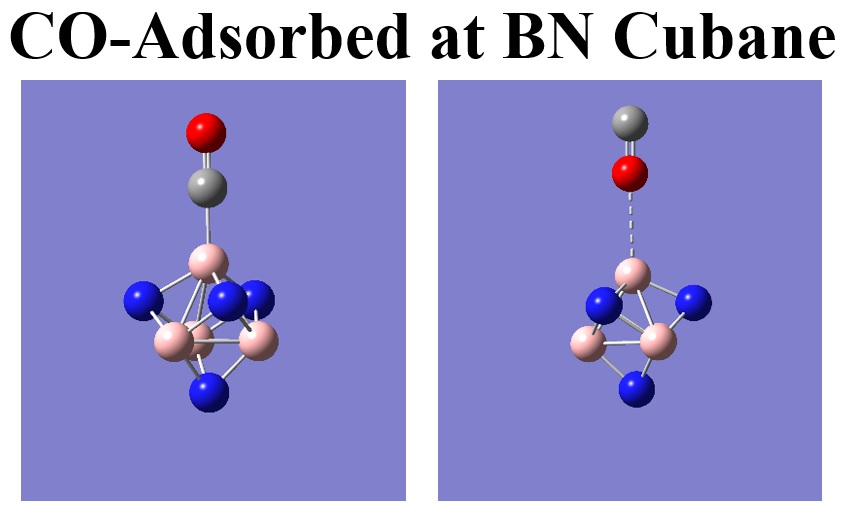DFT Calculations of a Cubic B4N4 Cubane-Like Particle for CO Gas Adsorption
DOI:
https://doi.org/10.22034/advjscieng21022093Keywords:
Boron nitride, Cubane, Carbon monoxide, Gas adsorption, DFTAbstract
A cubic boron-nitride (B4N4) cubane-like model was investigated in this work for carbon monoxide (CO) gas adsorption through performing density functional theory (DFT) calculations. The parent model was optimized first to be prepared for participating in CO adsorption process. Next, bi-molecular models of B4N4 and CO were optimized, in which two models were obtained regarding the orientation of CO in C and O direction towards the B4N4 model. In addition to the optimized structures, molecular orbitals features were also obtained for the models regarding the highest occupied and the lowest unoccupied ones (HOMO and LUMO). Related features including other parameters in both quantitative values and qualitative representation were all obtained for the models. The results indicated that the proposed cubic B4N4 cubane-like model could work for sensing and removal purposes of CO gas, which could be detectable by means of infrared (IR) and ultra-violet (UV) spectroscopic measurements.
References
Nazemi H, Joseph A, Park J, Emadi A. Advanced micro-and nano-gas sensor technology: a review. Sensors. 2019;19:1285.
Malik R, Tomer VK, Mishra YK, Lin L. Functional gas sensing nanomaterials: A panoramic view. Applied Physics Reviews. 2020;7:021301.
Kumar R, Jenjeti RN, Sampath S. Two-dimensional, few-layer MnPS3 for selective NO2 gas sensing under ambient conditions. ACS Sensors. 2020;5:404-411.
Lee SH, Eom W, Shin H, Ambade RB, Bang JH, Kim HW, Han TH. Room-temperature, highly durable Ti3C2TxMXene/graphene hybrid fibers for NH3 gas sensing. ACS Applied Materials & Interfaces. 2020;12:10434-10442.
Iranimanesh A, Yousefi M, Mirzaei M. DFT approach on SiC nanotube for NO2 gas pollutant removal. Lab-in-Silico. 2021;2:38-43.
Singh S, Singh A, Singh A, Tandon P. An efficient room-temperature liquefied petroleum gas sensor based on trirutile copper antimonate nano-polygons. New Journal of Chemistry. 2020;44:11949-11958.
Gholami P, Rashidi A, Khaleghi Abbasabadi M, Pourkhalil M, Jahangiri M, Izadi N. Synthesis and characterization of ZnO-functionalized multiwall carbon nanotubes nanocomposite as NOx gas sensor. Research on Chemical Intermediates. 2020;46:3911-3927.
El-Shamy AG. New nano-composite based on carbon dots (CDots) decorated magnesium oxide (MgO) nano-particles (CDots@ MgO) sensor for high H2S gas sensitivity performance. Sensors and Actuators B. 2021;329:129154.
Nakarungsee P, Srirattanapibul S, Issro C, Tang IM, Thongmee S. High performance Cr doped ZnO by UV for NH3 gas sensor. Sensors and Actuators A. 2020;314:112230.
Fallahpour F, Ariaei S. Computational investigation of B6 particle for H2S capturing. Advanced Journal of Science and Engineering. 2021;2:31-35.
Li J, Yan H, Dang H, Meng F. Structure design and application of hollow core microstructured optical fiber gas sensor: a review. Optics & Laser Technology. 2021;135:106658.
Valdés-López VF, Mason T, Shearing PR, Brett DJ. Carbon monoxide poisoning and mitigation strategies for polymer electrolyte membrane fuel cells–a review. Progress in Energy and Combustion Science. 2020;79:100842.
Siracusa R, Schaufler A, Calabrese V, Fuller PM, Otterbein LE. Carbon monoxide: from poison to clinical trials. Trends in Pharmacological Sciences. 2021;42:329-339.
Mahajan S, Jagtap S. Metal-oxide semiconductors for carbon monoxide (CO) gas sensing: a review. Applied Materials Today. 2020;18:100483.
Sittisak P, Charinpanitkul T, Chalermsinsuwan B. Enhancement of carbon monoxide removal in an underground car park using ventilation system with single and twin jet fans. Tunnelling and Underground Space Technology. 2020;97:103226.
Biegasiewicz KF, Griffiths JR, Savage GP, Tsanaktsidis J, Priefer R. Cubane: 50 years later. Chemical Reviews. 2015;115:6719-6745.
Faramarzi R, Falahati M, Mirzaei M. Interactions of fluorouracil by CNT and BNNT: DFT analyses. Advanced Journal of Science and Engineering. 2020;1:62-66.
Zahedi H, Yousefi M, Mirzaei M. DFT investigation of AlP-doped BN nanotube for CO gas capturing. Lab-in-Silico. 2020;1:38-43.
Hussin F, Aroua MK. Recent trends in the development of adsorption technologies for carbon dioxide capture: a brief literature and patent reviews (2014–2018). Journal of Cleaner Production. 2020;253:119707.
Mirzaei M. Nanotechnology for science and engineering. Advanced Journal of Science and Engineering. 2020;1:67-68.
Mirzaei M. Making sense the ideas in silico. Lab-in-Silico. 2020;1:31-32.
Ariaei S, Fallahpour F, Basiri H, Moradi R. A DFT study of H2 molecule adsorption at the fullerene-like boron carbide nanocage. Advanced Journal of Science and Engineering. 2021;2:18-22.
Mirzaei M. Science and engineering in silico. Advanced Journal of Science and Engineering. 2020;1:1-2.
Frisch, M.; Trucks, G.; Schlegel, H.; Scuseria, G.; Robb, M.; Cheeseman, J.; Montgomery Jr, J.; Vreven, T.; Kudin, K.; Burant, J. Gaussian 09 D.01 Program. Gaussian. Inc.: Wallingford, CT, USA. 2009.
Klimeš J, Bowler DR, Michaelides A. Chemical accuracy for the van der Waals density functional. Journal of Physics. 2009;22:022201.
Ariaei S. DFT approach on arsine and phosphine gases adsorption at the surface of B16C16 nanocluster. Lab-in-Silico. 2020;1:44-49.
Mirali M, Jafariazar Z, Mirzaei M. Loading tacrine Alzheimer’s drug at the carbon nanotube: DFT approach. Lab-in-Silico. 2021;2:3-8.
Agil H, Akduran N. Structural, electrical and magnetic properties of FeO added GdBaCuO superconductors. Advanced Journal of Science and Engineering. 2020;1:122-127.
Ozkendir OM. Temperature dependent XAFS study of CrFe2O4. Lab-in-Silico. 2020;1:33-37.
Jahangir M, Iqbal ST, Shahid S, Siddiqui IA, Ulfat I. MATLAB simulation for teaching projectile motion. Advanced Journal of Science and Engineering. 2020;1:59-61.

Downloads
Published
How to Cite
Issue
Section
License
Copyright (c) 2021 Advanced Journal of Science and Engineering

This work is licensed under a Creative Commons Attribution 4.0 International License.
This work is licensed under a Creative Commons Attribution 4.0 International License (CC-BY 4.0).



